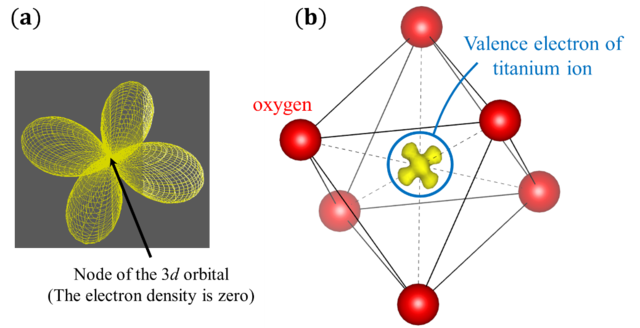Oct 29 2020
Researchers from Nagoya University have explored the smeared-out spatial distribution of a single valence electron at the core of a titanium oxide molecule. They achieved this through synchrotron X-ray diffraction and a new Fourier synthesis technique they devised.
 (a) Distribution of a butterfly-shaped 3d electron orbital. (b) Valence electron density distribution around the titanium (Ti3+) ion at the center of the titanium oxide (TiO6) octahedron obtained by the CDFS analysis developed by the research team for this project. Image Credit: Shunsuke Kitou.
(a) Distribution of a butterfly-shaped 3d electron orbital. (b) Valence electron density distribution around the titanium (Ti3+) ion at the center of the titanium oxide (TiO6) octahedron obtained by the CDFS analysis developed by the research team for this project. Image Credit: Shunsuke Kitou.
The technique can be used to find out the orbital states in materials irrespective of their physical properties and without performing tough experiments or analytical procedures. The research was recently reported in Physical Review Research.
The orbital state of the outermost electrons, or valence electrons, of the constituent atoms largely governs the physical properties and functions of solid materials, such as magnetic order and exceptional superconductivity.
In simple terms, the least unit that governs the physical properties of a solid material could include the orbitals occupied by the valence electrons. Furthermore, an orbital can even be regarded as a minimal unit of “shape,” so the orbital state in a solid can be inferred by studying the spatially anisotropic distribution of electrons (simply put, from how the electron distribution digresses from spherical symmetry).
The orbital states in elements constitute the fundamental knowledge that can be acquired from quantum chemistry or quantum mechanics textbooks. For instance, the 3d electrons in transition elements such as nickel and iron have typical gourd-type or butterfly-type shapes. However, thus far, it has been very hard to directly view the real-space distribution of such electron orbitals.
At present, using synchrotron X-ray diffraction, a research collaboration between Nagoya University, University of Wisconsin-Milwaukee, Japan’s RIKEN and Institute for Molecular Science, the University of Tokyo, and the Japan Synchrotron Radiation Research Institute (JASRI) has viewed the butterfly-shaped spatial distribution of a single valence electron at the core of an octahedron-shaped titanium oxide molecule.
The researchers examined the X-ray diffraction data from the titanium oxide specimen by formulating a Fourier synthesis technique wherein data from the inner shell electrons—which do not influence the physical properties of the compound—of each titanium ion are deducted from the total electron distribution of each ion, which leaves behind just the butterfly-shaped valence electron density distribution.
The technique is referred to as core differential Fourier synthesis (CDFS).
Moreover, a closer examination of the butterfly-shaped electron density showed that high density remained in the core region, contrary to bare titanium wherein electrons do not exist at the core because of the node of the 3d orbital. A closer analysis of the data revealed that the electron density at the core includes the valence electrons populating the hybridized orbital produced by the bond between oxygen and titanium.
First-principles calculations verified this non-trivial orbital picture and replicated the results of the CDFS analysis perfectly. The image directly shows the recognized Kugel-Khomskii model of the relationship between the orbital-ordered and magnetic states.
The CDFS technique can find out the orbital states in materials irrespective of the physical properties and can be applied to nearly all elements without performing tough experiments or analytical methods: the technique necessitates neither quantum-mechanical nor informatic models, thus reducing the bias added by analysts.
The results may signify a step ahead in the study of orbital states in materials. The CDFS analysis will be a benchmark for a comprehensive description of the electronic state by first-principles or other theoretical calculations.
This study was funded by a Grant-in-Aid for Scientific Research (No. JP23244074, JP19J11697) from JSPS. The synchrotron radiation experiments were carried out at SPring-8 with approval from the Japan Synchrotron Radiation Research Institute (JASRI) (Proposal No. 2011B0083 and No. 2019A0070).
Journal Reference:
Kitou, S., et al. (2020) Collapse of the simple localized 3d1 orbital picture in Mott insulator. Physical Review Research. doi.org/10.1103/PhysRevResearch.2.033503.